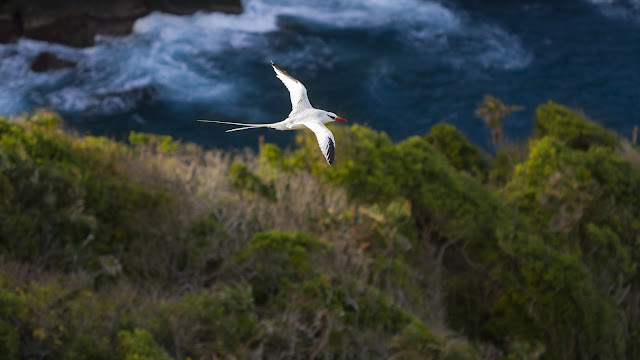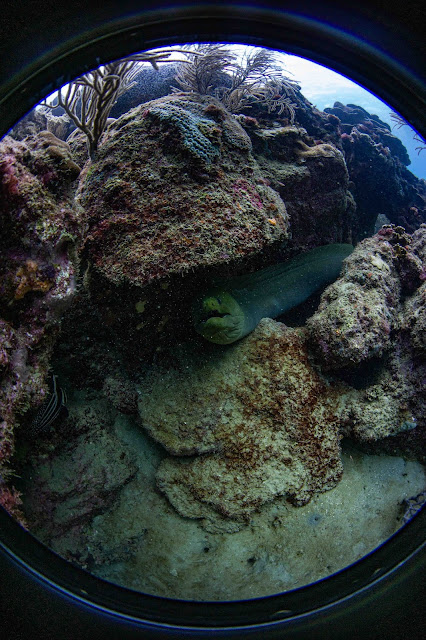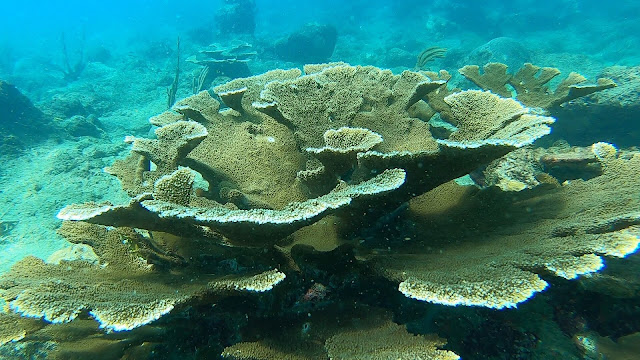Conservation for human well-being
Marine scientist, Dr Michelle Cazabon-Mannette, introduces the idea of conservation for human health and well-being, and suggests activities that the average citizen should engage in, to keep Tobago green and serene. First published in Tobago Newsday on Thursday, April 20, 2017
Previous articles in this column have touched on some of the ways we benefit from the environment. This week I’ll focus on the link between healthy marine ecosystems and human well-being, to illustrate why conservation is important. I’ll also talk about the keys to a successful conservation strategy, and what we can all do to help conserve the environment.
Healthy, functioning ecosystems perform a range of services that tend to go unnoticed, but upon which we heavily rely for all facets of our well-being including security, shelter, food and water, health, recreation and culture. These ecosystem services are divided into the categories of provisioning, regulating, cultural and supporting services. Healthy coral reefs for example, support the fisheries industry (provisioning), provide essential shoreline protection (supporting), play a vital role in the regulation of climate (regulating), and provide recreation and tourism opportunities (cultural). Therefore it is in our own best interest to work towards maintaining these services, and that is what conservation is about. More than simply trying to boost numbers of rare species, conservation is about promoting sustainable healthy functioning ecosystems so that we might continue enjoying their benefits.
This is no small task, and it requires that we first understand the components of the ecosystem and how they function together, and how our actions threaten the system.
There are broad scale threats such as climate change and plastic pollution that have negative impacts throughout the environment, and there are threats at a more limited scale that may directly impact only a few species. When we examine the role of each species however, we may come to understand how an impact seemingly limited to a single species may in fact have wider effects throughout the ecosystem.
Each species in an ecosystem has a role to play in the food chain whether as producers of energy, consumers, predators or as prey to others. Some species are critical to nutrient cycling by transporting nutrients from one place to another, while others may contribute to the physical structure of an ecosystem and provide shelter for other species. Each species then contributes to the ecosystem structure and functions in a number of ways. In many cases there is a degree of redundancy, where multiple species perform a similar role, so that the loss of one may be compensated for by the presence of another. But in some cases, a species plays such a unique, critical role, that if its population is depleted or even lost, it can cause ripple effects throughout the ecosystem with major repercussions. Such species are called keystone species because of their unique roles and disproportionate effect on the ecosystem.
Keystone species in marine ecosystems include: parrot fish (which are important reef herbivores grazing on algae which may smother coral); several shark species (which are top predators and act to control the prey population); large herbivores such as manatees and green turtles (which graze on seagrass beds and maintain their productivity); hawksbill turtles (which have a unique diet feeding primarily on sponge – a simple animal which competes with coral for space); reef-building hard corals (which contribute to structural complexity of the reef and provide shelter for a variety of smaller mobile species including fish, eels, crabs, lobsters); leatherback turtles (which feed primarily on jellyfish which don’t have many predators but which prey on fish larvae).
All sea turtles serve as important nutrient transporters, gaining nutrients in the habitats where they eat, and depositing a portion at beaches where they nest. These key species then, are often the subject of targeted conservation efforts when their numbers are observed to decline. There can be a tendency to focus on simply helping boost the population numbers, without a view to the broader ecosystem context. However, the aim should be restoring the population to levels at which they can fulfil their ecological roles, consistent with the broader goal of restoring functioning ecosystems to where we continue to benefit from their services.
With this goal in mind, the key principle behind effective conservation is reducing or eliminating the threats that are causing a decline in numbers in the first place. Programs that involve removing animals from the wild for the purpose of breeding for example, do nothing to address the threats that are causing decline in the first place, and may cause more harm than good by removing animals from the roles that they should be fulfilling; and therefore interfere with the functioning ecosystem. Conservation strategies therefore, should revolve around managing human behaviour to reduce our impacts, while reserving direct interference as a last resort when other management measures are not sufficient. Such measures include regulation of natural resource exploitation, minimizing our waste and generally regulating how, when and where we interact with the environment.
Everyone can do their part towards conservation by making better informed choices. Here are a few ways to start:
• Avoid single use plastics as far as possible. That means plastic bags, food containers, disposable plastic bottles, cups, straws and cutlery. Use re-usable products instead.
• Never leave litter behind. Litter anywhere, no matter how small and even far away from the coast, will eventually wash down to the sea.
• Stay informed and make informed decisions about what food you eat, products you use and activities you participate in.
• Finally, help spread the word. Teach your family and friends, and speak up when you observe someone acting inappropriately. Help them to understand why it’s important and help them make better choices.
 |
| Parrot fish have an important role in healthy coral reefs, grazing on algae, photo by Ryan P. Mannette |
Previous articles in this column have touched on some of the ways we benefit from the environment. This week I’ll focus on the link between healthy marine ecosystems and human well-being, to illustrate why conservation is important. I’ll also talk about the keys to a successful conservation strategy, and what we can all do to help conserve the environment.
Healthy, functioning ecosystems perform a range of services that tend to go unnoticed, but upon which we heavily rely for all facets of our well-being including security, shelter, food and water, health, recreation and culture. These ecosystem services are divided into the categories of provisioning, regulating, cultural and supporting services. Healthy coral reefs for example, support the fisheries industry (provisioning), provide essential shoreline protection (supporting), play a vital role in the regulation of climate (regulating), and provide recreation and tourism opportunities (cultural). Therefore it is in our own best interest to work towards maintaining these services, and that is what conservation is about. More than simply trying to boost numbers of rare species, conservation is about promoting sustainable healthy functioning ecosystems so that we might continue enjoying their benefits.
This is no small task, and it requires that we first understand the components of the ecosystem and how they function together, and how our actions threaten the system.
There are broad scale threats such as climate change and plastic pollution that have negative impacts throughout the environment, and there are threats at a more limited scale that may directly impact only a few species. When we examine the role of each species however, we may come to understand how an impact seemingly limited to a single species may in fact have wider effects throughout the ecosystem.
Each species in an ecosystem has a role to play in the food chain whether as producers of energy, consumers, predators or as prey to others. Some species are critical to nutrient cycling by transporting nutrients from one place to another, while others may contribute to the physical structure of an ecosystem and provide shelter for other species. Each species then contributes to the ecosystem structure and functions in a number of ways. In many cases there is a degree of redundancy, where multiple species perform a similar role, so that the loss of one may be compensated for by the presence of another. But in some cases, a species plays such a unique, critical role, that if its population is depleted or even lost, it can cause ripple effects throughout the ecosystem with major repercussions. Such species are called keystone species because of their unique roles and disproportionate effect on the ecosystem.
 |
| A hawksbill turtle glides over a reef in Tobago, where it feeds on the abundant sponge, photo by Ryan P. Mannette |
Keystone species in marine ecosystems include: parrot fish (which are important reef herbivores grazing on algae which may smother coral); several shark species (which are top predators and act to control the prey population); large herbivores such as manatees and green turtles (which graze on seagrass beds and maintain their productivity); hawksbill turtles (which have a unique diet feeding primarily on sponge – a simple animal which competes with coral for space); reef-building hard corals (which contribute to structural complexity of the reef and provide shelter for a variety of smaller mobile species including fish, eels, crabs, lobsters); leatherback turtles (which feed primarily on jellyfish which don’t have many predators but which prey on fish larvae).
All sea turtles serve as important nutrient transporters, gaining nutrients in the habitats where they eat, and depositing a portion at beaches where they nest. These key species then, are often the subject of targeted conservation efforts when their numbers are observed to decline. There can be a tendency to focus on simply helping boost the population numbers, without a view to the broader ecosystem context. However, the aim should be restoring the population to levels at which they can fulfil their ecological roles, consistent with the broader goal of restoring functioning ecosystems to where we continue to benefit from their services.
With this goal in mind, the key principle behind effective conservation is reducing or eliminating the threats that are causing a decline in numbers in the first place. Programs that involve removing animals from the wild for the purpose of breeding for example, do nothing to address the threats that are causing decline in the first place, and may cause more harm than good by removing animals from the roles that they should be fulfilling; and therefore interfere with the functioning ecosystem. Conservation strategies therefore, should revolve around managing human behaviour to reduce our impacts, while reserving direct interference as a last resort when other management measures are not sufficient. Such measures include regulation of natural resource exploitation, minimizing our waste and generally regulating how, when and where we interact with the environment.
Everyone can do their part towards conservation by making better informed choices. Here are a few ways to start:
• Avoid single use plastics as far as possible. That means plastic bags, food containers, disposable plastic bottles, cups, straws and cutlery. Use re-usable products instead.
• Never leave litter behind. Litter anywhere, no matter how small and even far away from the coast, will eventually wash down to the sea.
• Stay informed and make informed decisions about what food you eat, products you use and activities you participate in.
• Finally, help spread the word. Teach your family and friends, and speak up when you observe someone acting inappropriately. Help them to understand why it’s important and help them make better choices.



